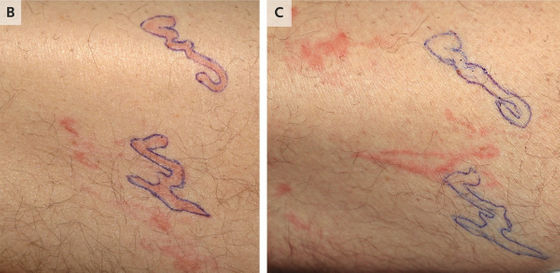Reports of 'massive parasitic nematodes entering through the anus and crawling under the skin of the entire body'

A Spanish doctor reported a case in which a large number of parasitic nematodes entered the body through the anus, traveled subcutaneously, and spread throughout the body.
Larva Currens in Strongyloides Hyperinfection Syndrome | NEJM
Army of worm larvae hatch from man's bum, visibly slithering under his skin | Ars Technica
https://arstechnica.com/science/2022/04/army-of-worm-larvae-hatch-from-mans-bum-visibly-slither-under-his-skin/
The case in question was reported by Mario Puerta-Peña of Spain and his colleagues in the peer-reviewed medical journal New England Journal of Medicine, and concerns a nematode called Strongyloides stercoralis . When Strongyloides stercoralis comes into contact with contaminated soil or sewage as a larva, it breaks through the skin of the organism and invades the body, then travels to the lungs via the heart via the bloodstream or lymphatic system. It then travels from the alveoli up the trachea to the mouth, from where it is swallowed by the infected person and travels to the intestines. The ecology of this nematode is that it grows and reproduces in the intestines, then leaves the body with feces and spreads the infection.

The case reported here is a rare case of Strongyloides stercoralis 're-invading' through the skin around the anus after being discharged with feces. The patient was a 64-year-old sewage worker who had previously been diagnosed with metastatic lung cancer. After being infected with Strongyloides stercoralis, he was administered a cancer hormone therapy drug, which suppressed his immune response, creating an internal environment favorable for the proliferation of Strongyloides stercoralis.
Below is an image of an actual patient. The red part is Strongyloides stercoralis wriggling under the skin, but since Strongyloides stercoralis is said to be itchy, it is thought that there are also scars from the patient scratching it.

The following two images show that Puerta-Peña and his colleagues used a pen to make the subcutaneous Strongyloides stercoralis easier to understand. The Strongyloides stercoralis shown in the left and right images is the same individual, and it moved from the position in the left image to the position in the right image in 24 hours.

According to the report, Puerta-Peña and his colleagues determined that the red rash was a parasite because it was moving, and confirmed the diagnosis by confirming the larvae of Strongyloides stercoralis in a stool test. After this diagnosis, Puerta-Peña and his colleagues administered the antiparasitic drug ivermectin to the patient to treat the rash and diarrhea.
Related Posts:







